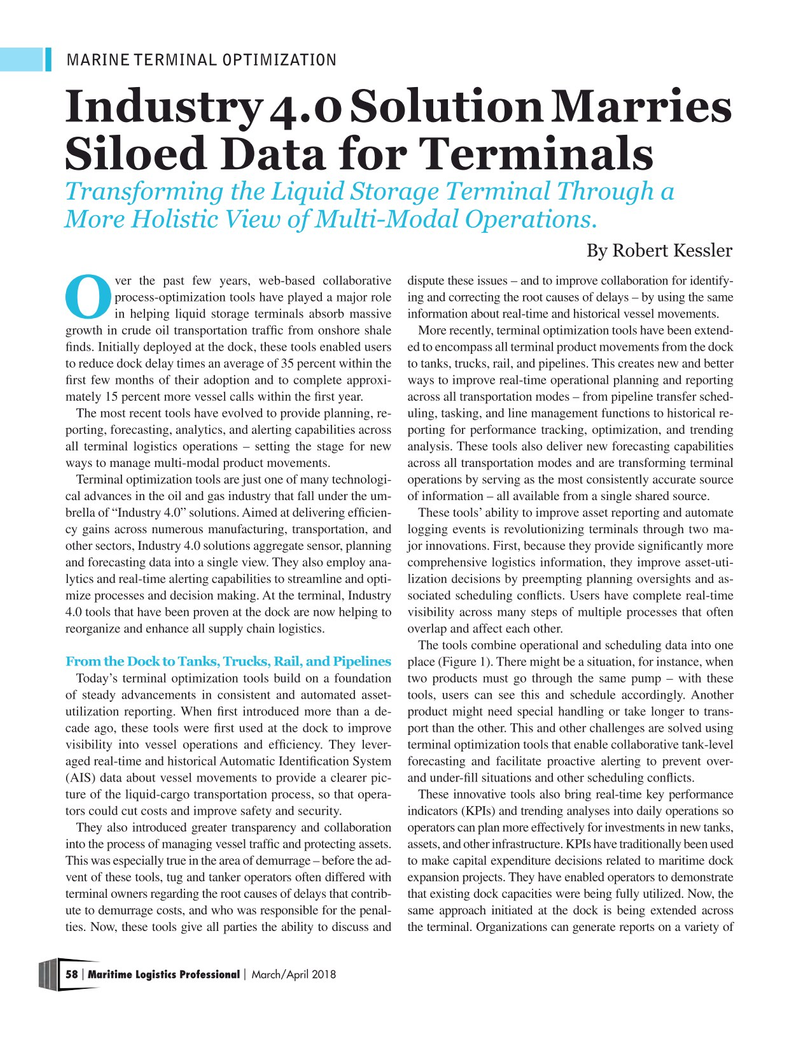
Page 58: of Maritime Logistics Professional Magazine (Mar/Apr 2018)
IT & Software
Read this page in Pdf, Flash or Html5 edition of Mar/Apr 2018 Maritime Logistics Professional Magazine
MARINE TERMINAL OPTIMIZATION
Industry 4.0 Solution Marries
Siloed Data for Terminals
Transforming the Liquid Storage Terminal Through a
More Holistic View of Multi-Modal Operations.
By Robert Kessler ver the past few years, web-based collaborative dispute these issues – and to improve collaboration for identify- process-optimization tools have played a major role ing and correcting the root causes of delays – by using the same
O in helping liquid storage terminals absorb massive information about real-time and historical vessel movements.
growth in crude oil transportation traffc from onshore shale More recently, terminal optimization tools have been extend- fnds. Initially deployed at the dock, these tools enabled users ed to encompass all terminal product movements from the dock to reduce dock delay times an average of 35 percent within the to tanks, trucks, rail, and pipelines. This creates new and better frst few months of their adoption and to complete approxi- ways to improve real-time operational planning and reporting mately 15 percent more vessel calls within the frst year. across all transportation modes – from pipeline transfer sched-
The most recent tools have evolved to provide planning, re- uling, tasking, and line management functions to historical re- porting, forecasting, analytics, and alerting capabilities across porting for performance tracking, optimization, and trending all terminal logistics operations – setting the stage for new analysis. These tools also deliver new forecasting capabilities ways to manage multi-modal product movements. across all transportation modes and are transforming terminal
Terminal optimization tools are just one of many technologi- operations by serving as the most consistently accurate source cal advances in the oil and gas industry that fall under the um- of information – all available from a single shared source. brella of “Industry 4.0” solutions. Aimed at delivering effcien- These tools’ ability to improve asset reporting and automate cy gains across numerous manufacturing, transportation, and logging events is revolutionizing terminals through two ma- other sectors, Industry 4.0 solutions aggregate sensor, planning jor innovations. First, because they provide signifcantly more and forecasting data into a single view. They also employ ana- comprehensive logistics information, they improve asset-uti- lytics and real-time alerting capabilities to streamline and opti- lization decisions by preempting planning oversights and as- mize processes and decision making. At the terminal, Industry sociated scheduling conficts. Users have complete real-time 4.0 tools that have been proven at the dock are now helping to visibility across many steps of multiple processes that often reorganize and enhance all supply chain logistics. overlap and affect each other.
The tools combine operational and scheduling data into one
From the Dock to Tanks, Trucks, Rail, and Pipelines place (Figure 1). There might be a situation, for instance, when
Today’s terminal optimization tools build on a foundation two products must go through the same pump – with these of steady advancements in consistent and automated asset- tools, users can see this and schedule accordingly. Another utilization reporting. When frst introduced more than a de- product might need special handling or take longer to trans- cade ago, these tools were frst used at the dock to improve port than the other. This and other challenges are solved using visibility into vessel operations and effciency. They lever- terminal optimization tools that enable collaborative tank-level aged real-time and historical Automatic Identifcation System forecasting and facilitate proactive alerting to prevent over- (AIS) data about vessel movements to provide a clearer pic- and under-fll situations and other scheduling conficts. ture of the liquid-cargo transportation process, so that opera- These innovative tools also bring real-time key performance tors could cut costs and improve safety and security. indicators (KPIs) and trending analyses into daily operations so
They also introduced greater transparency and collaboration operators can plan more effectively for investments in new tanks, into the process of managing vessel traffc and protecting assets. assets, and other infrastructure. KPIs have traditionally been used
This was especially true in the area of demurrage – before the ad- to make capital expenditure decisions related to maritime dock vent of these tools, tug and tanker operators often differed with expansion projects. They have enabled operators to demonstrate terminal owners regarding the root causes of delays that contrib- that existing dock capacities were being fully utilized. Now, the ute to demurrage costs, and who was responsible for the penal- same approach initiated at the dock is being extended across ties. Now, these tools give all parties the ability to discuss and the terminal. Organizations can generate reports on a variety of 58 Maritime Logistics Professional March/April 2018 | |

 57
57

 59
59
